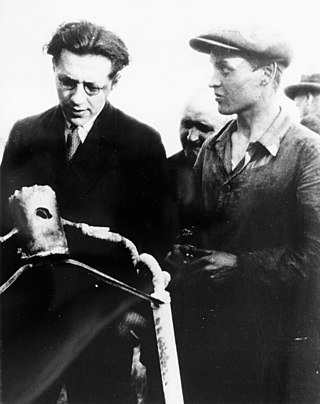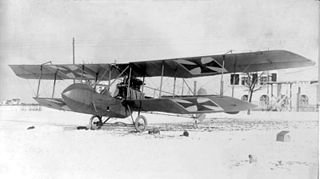Related Research Articles

Hermann Julius Oberth was an Austro-Hungarian-born German physicist and rocket pioneer of Transylvanian Saxon descent. He is considered one of the founding fathers of rocketry and astronautics, along with Robert Esnault-Pelterie, Konstantin Tsiolkovsky, Robert H. Goddard and Herman Potočnik. Oberth supported Nazi Germany's war effort and received the War Merit Cross in 1943.

The German Aerospace Center is the national center for aerospace, energy and transportation research of Germany, founded in 1969. It is headquartered in Cologne with 35 locations throughout Germany. The DLR is engaged in a wide range of research and development projects in national and international partnerships.

Großenkneten is a municipality in the district of Oldenburg, in Lower Saxony, Germany.
Hespenbusch is a farm, which belongs to the municipality of Grossenkneten. Karl Poggensee and the Hermann Oberth society operated between 1952 and 1957 a launch site for small rockets with a maximum flight level of some kilometers, close to this farm. In 1957 the launch activities were shifted toward Cuxhaven, since the available area became too small.
The Berthold Seliger Forschungs- und Entwicklungsgesellschaft mbH (BSFEGmbH) was a company founded by West German rocket technical designer Berthold Seliger in 1961. Seliger was a former assistant theoretician professor Dr. Eugen Sänger. The company developed and built prototypes of sounding rockets and launched them near Cuxhaven. The BSFEGmbH cooperated strongly with the Hermann-Oberth-Gesellschaft, of which Berthold Seliger was a member. The first rocket developed by the BSFEGmbH was an improved version of the Kumulus, which was first launched on 19 November 1962 and reached a height of 50 kilometres. On 7 February 1963 the BSFEGmbH launched a two-stage rocket with a maximum height of 80 kilometres and, on 2 May 1963, they launched a three-stage rocket with a maximum flight height of more than 100 kilometres. The latter rocket may have attained the highest flight altitude of all rockets built in post-war Germany. The signals from all these rockets were also received at the observatory in Bochum. After May 1963 the BSFEGmbH worked on the improvement of the steering system of their rockets and thought also on military usable rockets.
Kumulus is the name of a rocket of the "Hermann-Oberth-Gesellschaft e.V.". The first Kumulus rocket was launched on December 20, 1960, near Cuxhaven. A Kumulus rocket is on display at the Hermann Oberth Space Travel Museum in Feucht.
Gerhard Zucker (1908–1985) was a German businessman and rocket engineer.

Arensch is a local part of Cuxhaven, a town in Lower Saxony, Germany.
Between 1933 and 1964 numerous rocket experiments were carried out in the area of Cuxhaven, Germany.
Seliger Rocket is the designation for the sounding rockets of the Berthold Seliger Forschungs- und Entwicklungsgesellschaft mbH. They were
- A single-stage rocket with a length of 3.4 metres and a takeoff thrust of 50 kN. This rocket was first launched on November 19, 1962, near Cuxhaven and reached a height of 40 km.
- A two-stage rocket with a length of 6 metres and a takeoff thrust of 50 kN. This rocket was first launched on February 7, 1963, and reached a height of 80 km.
- A three-stage rocket with a length of 12.8 metres, a diameter of 0.56 metres and a takeoff thrust of 50 kN. This rocket was first launched on May 2, 1963, with reduced fuel and reached an altitude of 110 km. Later with maximum fuel it reached a height of 150 km.

The Hermann Oberth Space Travel Museum is a museum of space technology in the Franconian city of Feucht in Bavaria, Germany.
Hermann Schlichting was a German fluid dynamics engineer.

Roger Béteille was a French aeronautical engineer and businessman. Regarded as one of the founding fathers of the company, he is known for his contributions towards Airbus, which contributed towards the airline company's initial success. He also worked for Air France, Lufthansa, United, TWA and American Airlines.
German Society for Aeronautics and Astronautics is a German aerospace society. It was founded in 1912 under the name of Wissenschaftliche Gesellschaft für Flugtechnik (WGF). It is the second oldest technical and scientific society in aerospace in the world.

Heinz-Hermann Koelle was a German aeronautical engineer who made the preliminary designs on the rocket that would emerge as the Saturn I. Closely associated with Wernher von Braun's team at the Army Ballistic Missile Agency (ABMA), he was a member of the launch crew on Explorer 1 and later directed the Marshall Space Flight Center's involvement in Project Apollo. In 1965, he accepted the Chair of Space Technology at the Technical University of Berlin.

Association Aéronautique et Astronautique de France is the French national aeronautical and astronautical association. It is located in Paris.

Paul Ehmayr was a German-Austrian rocket engineer. He was a precision mechanic. His masterpiece was a barometer.

The Magdeburger Startgerät is a missile that was intended to ensure the first manned rocket flight in history. Despite successful tests, the pilot flight originally planned for March 1933 never took place. After several delays, the project was finally stopped in 1934 when the National Socialists prohibited all private missile attempts.
The Bundesverband der Deutschen Luft- und Raumfahrtindustrie (BDLI) is a German association of companies and institutions in the aerospace industry with its headquarters in Berlin, Germany.

The Royal Bavarian Flying Corps was the Army Air Force of the Bavarian Army from 1912 to 1920 and, together with the Royal Bavarian Airship Department, formed the air force of the Kingdom of Bavaria. During World War I, the troops were used as part of the German Air Force (Luftstreitkräfte) and then disbanded in accordance with the provisions of the Versailles Peace Treaty.
References
- ↑ Jahrbuch der Luft- und Raumfahrt. 1984.
- ↑ Reinhart Brandau (31 August 2016). Sinn des Lebens. BoD – Books on Demand. pp. 96–. ISBN 978-3-7412-5045-3.
- ↑ Erik Bergaust (15 September 2017). Wernher von Braun. Stackpole Books. pp. 553–. ISBN 978-0-8117-6623-4.
- ↑ Colin Burgess; Chris Dubbs (5 July 2007). Animals in Space: From Research Rockets to the Space Shuttle. Springer Science & Business Media. pp. 99–. ISBN 978-0-387-49678-8.
- ↑ T. L. Keller (6 November 2015). The Total Novice's Guide To UFOs: What You Need To Know. 2FS, LLC. pp. 534–. ISBN 978-1-944242-09-1.
- ↑ Hermann Oberth (1984) [1923], Die Rakete zu den Planetenräumen, Michaels-Verlag
- ↑ Marsha Freeman (1995), Hin zu neuen Welten. Die Geschichte der deutschen Raumfahrtpioniere, Böttiger Wiesbaden, ISBN 3-925725-22-9
- ↑ Harald Lutz (March 2003), Die vergessenen Raketenexperimente von Cuxhaven, Modellraketen-Magazin Countdown